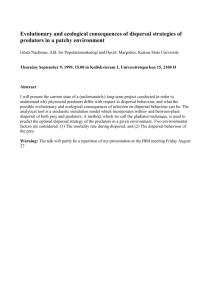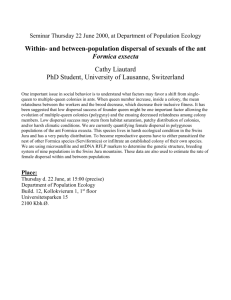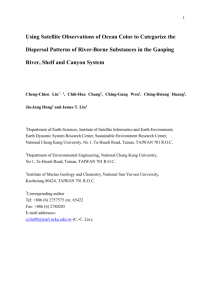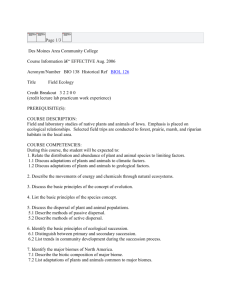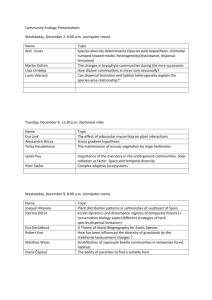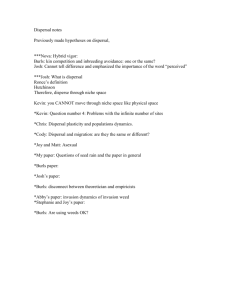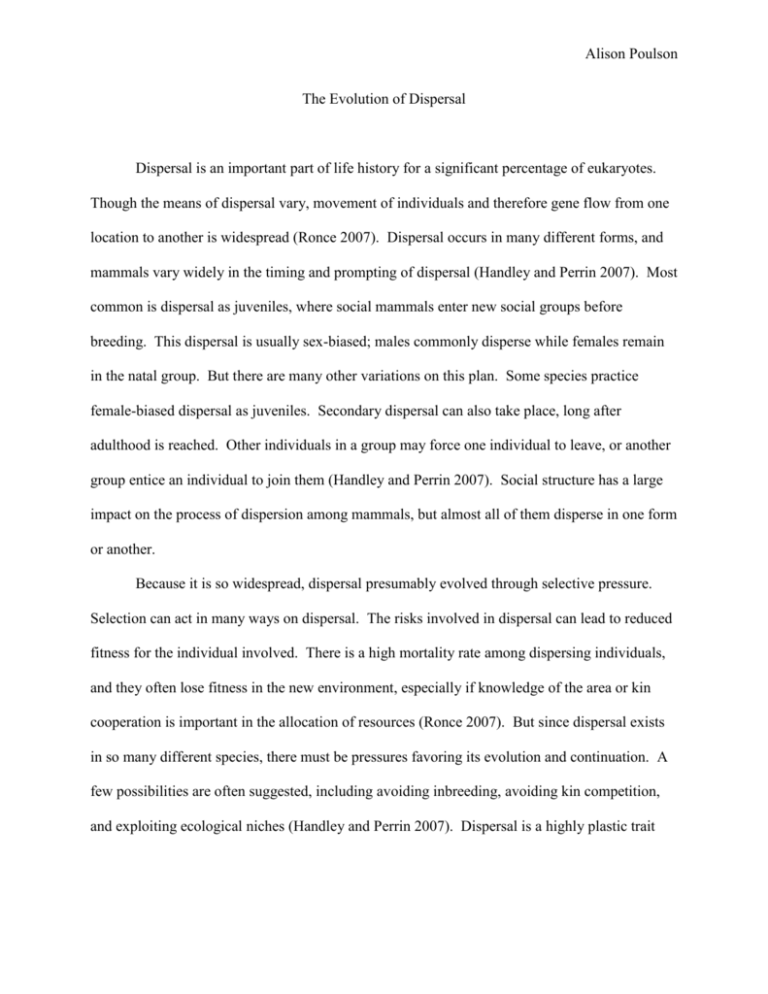
Alison Poulson
The Evolution of Dispersal
Dispersal is an important part of life history for a significant percentage of eukaryotes.
Though the means of dispersal vary, movement of individuals and therefore gene flow from one
location to another is widespread (Ronce 2007). Dispersal occurs in many different forms, and
mammals vary widely in the timing and prompting of dispersal (Handley and Perrin 2007). Most
common is dispersal as juveniles, where social mammals enter new social groups before
breeding. This dispersal is usually sex-biased; males commonly disperse while females remain
in the natal group. But there are many other variations on this plan. Some species practice
female-biased dispersal as juveniles. Secondary dispersal can also take place, long after
adulthood is reached. Other individuals in a group may force one individual to leave, or another
group entice an individual to join them (Handley and Perrin 2007). Social structure has a large
impact on the process of dispersion among mammals, but almost all of them disperse in one form
or another.
Because it is so widespread, dispersal presumably evolved through selective pressure.
Selection can act in many ways on dispersal. The risks involved in dispersal can lead to reduced
fitness for the individual involved. There is a high mortality rate among dispersing individuals,
and they often lose fitness in the new environment, especially if knowledge of the area or kin
cooperation is important in the allocation of resources (Ronce 2007). But since dispersal exists
in so many different species, there must be pressures favoring its evolution and continuation. A
few possibilities are often suggested, including avoiding inbreeding, avoiding kin competition,
and exploiting ecological niches (Handley and Perrin 2007). Dispersal is a highly plastic trait
Alison Poulson
and depends on conditions and social structure in the species and the particular habitat. This
paper investigates the factors that led to the evolution and persistence of dispersal in mammals.
For evolution to act on dispersal, it must be a heritable trait, there must be variety in that
trait, and that variation must lead to differences in fitness. Dispersal meets these criteria. First,
dispersal has a genetic basis, though it is easiest to show in insects and plants, where
morphology, often based on a single gene, can directly affect an individual's potential for
dispersal (Ronce 2007). In mammals, dispersal seems to be polygenetic in most species and very
plastic, but morphological and behavioral traits that influence dispersal have a significant
heritability, usually above 0.30 (Roff and Fairbarn 2001). Secondly, the plasticity of dispersal in
mammals shows the variation in the trait necessary for selection to act. One source of variation
is the distance that individuals disperse. An individual’s potential for dispersal distance can be
measured by body morphology; some individuals are better adapted for traveling long distances
(Roff and Fairbarn 2001). Dispersal rates also change based on ecological conditions, including
population density and social structure of the natal unit (Clobert et al 2004). Finally, dispersal
changes fitness and reproductive success for the individuals who disperse; the risk of mortality
during dispersal and difficulty in settling into a new environment can be countered by increased
fitness when inbreeding is avoided and the dispersed organism's kin have greater success without
increased competition (Johnson and Gaines 1990). The ways in which dispersal affects
reproductive success will be examined in more detail throughout the rest of the paper.
Dispersal is a risky activity. There is a high mortality rate during dispersal (Ronce
2007). One example of this risk is the dispersal of root voles. Like many rodents, voles
ordinarily live in burrows out of range of most of their predators, particularly raptors. Travelling
from one burrow to another places them in a vulnerable position. There is a higher death rate
Alison Poulson
from predatory birds among dispersing individuals (Ims and Andreassen 2000). The time spent
looking for a new habitat is dangerous, and individuals may accept a less-than-ideal habitat if the
search goes too long (Stamps et al 2005).
Even for those who survive and reach an optimal habitat, there are often disadvantages to
being a newcomer (Handley and Perrin 2007). If gathering food requires knowledge or control
of an area, dispersers risk not getting enough food in the new habitat. In species where control of
resources is important to attracting a mate, newly arrived dispersers have less chance of mating
(Handley and Perrin 2007). In highly organized social groups, newcomers are often at the
bottom of the pecking order, with little chance of mating. For example, when female torque
macaques joined a preexisting group, the new members were dominated by original group
members, placing them in the lowest ranks in the hierarchy and restricting their chances to mate
(Dittus 1987).
Dispersal traits are often tradeoffs for other life history traits (Ronce 2007). This is very
clear in insects; crickets with dysfunctional wings, reducing their potential for dispersal, had
enlarged ovaries, increasing their reproductive rate (Zera et al 1998). Dispersing also consumes
energy reserves. In non-dispersers, this energy could be used for reproduction. Dispersal
requires stamina; larger body size and fat reserves help individuals survive dispersal (Nunes and
Holecamp 1996). These traits may persist throughout life, requiring more food and energy than
a smaller individual that is not optimized for dispersal.
These factors seem to indicate that dispersal should not be favored by selection, but it is
very common. Researchers have posited several reasons for dispersal to persist. The first is
inbreeding avoidance (Handley and Perrin 2007). Inbreeding causes a high rate of deleterious
recessive alleles being expressed, increasing the mortality rate of the offspring. Dispersal
Alison Poulson
promotes gene flow, preventing the deleterious effects of inbreeding. Individuals have more
choice of mates and are less likely to end up mating with close kin. When inbreeding costs are
high, this advantage leads to a preference by the choosing sex (usually females) for mates who
have come from another natal group, over their closer kin (Lehmann and Perrin 2003). Then
sexual selection influences the other sex to disperse, and sex-biased dispersal becomes the norm.
This concept was very popular when dispersal was first studied in the seventies. Models
were created to show how dispersal counteracts inbreeding to maintain the strength of a
population (Johnson and Gaines 1990). However, data from the field did not always follow the
model. Inbreeding is not a fixed problem, as it was commonly thought earlier (Ronce 2007).
Changes in mutation rate and their effects on the species, and size of the population, all affect the
amount of harm inbreeding does and how much it is necessary to avoid it. And dispersal is not
the only counter to inbreeding; species with highly developed kin-recognition techniques may
not need dispersal to avoid inbreeding (Perrin and Lehmann 2001). However, such species often
still disperse. Also, the inbreeding avoidance model predicts that dispersal would tend toward all
of one sex dispersing, while all members of the opposite sex stayed in place. This would provide
the very least chance of inbreeding. However, this is never the case. Even in extremely sexbiased dispersal, not all members of the normal dispersing sex disperse. And in all species, some
members of the non-dispersing sex also leave for new groups (Handley and Perrin 2007). Other
factors than inbreeding avoidance are at work on the evolution of dispersal.
Another suggested cause for the evolution of dispersal is the avoidance of kin
competition (Hamilton and May 1977). This is highly related to inbreeding avoidance; dispersal
avoids both negative effects of having family members in too close proximity. If due to
dispersal, siblings are in different areas, they will not compete with each other for resources,
Alison Poulson
allowing each of them to maximize their fitness. Since a sibling has the same relatedness as
offspring, maximizing siblings' reproductive success is as useful for overall fitness as one's own
offspring's success. In this model, the evolution of dispersal is related to altruism. Individuals
might lose direct reproductive success, due to the mortality risks of dispersal, but indirect
reproductive success could actually be higher if their siblings had greater success due to their
actions (Ronce 2007).
If this model is accurate, dispersal should be most common when resources are strained
and there is overcrowding in the natal area. However, individuals often join together in dispersal
to form regions of high population density (Ronce 2007). Also, siblings often disperse together,
keeping them in competition with each other. For instance, in primates natal groups of juvenile
males often remain together and join a new group as a body (Handley and Perrin 2007). They
remain in competition for food and mates in the new group. This implies that kin competition
alone cannot be responsible for the evolution of dispersal.
Yet another factor in dispersal is its potential for exploiting more ecological niches
(Ronce 2007). If the habitat has a great deal of variation, dispersal of offspring might maximize
the chance that some of them will find areas with many resources and few competitors. One
individual might be more suited than another for a certain habitat, and dispersal allows this
variation to increase each individual's fitness. If the environment is constantly changing, a high
degree of mobility may mean that offspring can find new areas to which they are adapted when
the natal area changes to be less appropriate for the species. If the habitat is deteriorating over
time, dispersal will be favored, and offspring can find new, untouched areas of habitat. This can
be seen in red squirrels, which disperse more in areas with a great deal of variation in food
availability than in a stable habitat (Lurz et al 1997). However, even in a stable habitat dispersal
Alison Poulson
takes place. Exploiting new niches is a potential benefit of dispersal, but it is not the only causal
factor.
The factors that affect dispersal evolution are also often sex-specific. Females usually
pay a higher price of inbreeding depression than males, for instance, and one sex usually has the
responsibility for defending the territory, affecting the dispersal patterns. Complex social
networks among one sex reduce the likelihood of dispersal by that sex and increase it in the other
sex (Handley and Perrin 2007). As a result, dispersal in mammals is usually sex-biased; one sex
disperses more than the other. If both sexes disperse, they usually travel different distances,
which reduces inbreeding (Handley and Perrin 2007). But which sex disperses and how far they
go varies widely between species.
All of these factors interact in each population. One population may respond to changing
habitat by decreasing reproductive rates, and the lack of overcrowding might mean that less
individuals disperse (Ronce 2007). Another population may have very little inbreeding due to
kin recognition, but lack of resources leads to widespread dispersal of both sexes. The factors
that affect dispersal are too complicated to be accurately modeled at this point (Ronce 2007).
Dispersal is complicated because it is a highly plastic trait. Though offspring of
dispersed parents are more likely to disperse themselves, the chance is mediated by many other
factors. Most mammals practice conditional dispersal; whether or not dispersal takes place,
where and how far an individual goes, and the timing of dispersal are all affected by the situation
(Bowler and Benton 2005). Individuals can make the choice to disperse or to stay at the natal
site, which neighboring group to join, and when to move. These choices are moderated by
resource availability, actions of other members of the group, and interactions with non-group
members. For instance, among rodents, dispersal is much more common when resources around
Alison Poulson
the natal burrow are scarce (Ronce 2007). If an individual burrow is important for reproduction,
as in red squirrels, and the mother bequeaths her burrow to one of the daughters, the others are
more likely to disperse to find their own burrows (Price and Boutin 1993). Among primates, a
major cause of post-juvenile male dispersal is aggression from other males. Adolescents
approaching maturity are forcibly driven from the group by the dominant male in gibbons and
howler monkeys (Handley and Perrin 2007). Juvenile male baboons and macaques are attracted
to other groups by the actions of the other females; when two populations come into contact
during mating season, females attract males and invite them into their group (Handley and Perrin
2007). All of these factors affect the rate of dispersal among a population. They make dispersal
difficult to model and are responsible for the variety of forms of dispersal that exist in different
organisms.
Mammals with complex social structures have particularly complicated dispersal
patterns. The more complex the social structure, the more sex-biased dispersal takes place; one
sex forms powerful social bonds and gains kin benefits by philopatry, while the other disperses
to avoid inbreeding. Social structure heavily affects who disperses, when, and why (Bowler and
Benton 2005). This has been most studied in primates (Hammond et al 2006). Most primates
live in harems where one male controls many females. Juvenile males leave the group as they
approach maturity in order to join other groups where they may someday become the breeding
male. However, this is not always the case. In gorillas and chimpanzees, juvenile females leave
the group (Clutton-Brock 1989). This seems to follow the inbreeding avoidance theory; the
females leave in order to avoid breeding with their potential father. In some groups, juveniles
leave as a group and attempt to take over another group as a gang (Handley and Perrin 2007).
Alison Poulson
This is explicable by kin selection; the benefit may be greater for a weak male to help a stronger
brother reproduce than to attempt to reproduce himself.
Females are not inactive in this process, even in primates where the males usually control
breeding rights by aggression (Hammond et al 2006). Females can lure males from one group
into another when the two groups come into contact. In other groups, females have the final
choice over whether or not a male is allowed to join the group. Sometimes females drive out
other females in competition for limited resources (Handley and Perrin 2007).
Dispersal is an important source of gene flow in populations (Ronce 2007). It is
important to understand dispersal in order to see how small populations avoid inbreeding and
continue to persist. Understanding the pressures that led to the evolution of dispersal and its
persistence allows researchers to understand how species survive the pressures of a constantly
changing environment. It also allows practical applications in conservation biology. Many
populations are becoming isolated by human activity, and the lack of gene flow leads to
inbreeding depression. In order to prevent these populations from dying out, conservation
biologists need to introduce or reintroduce a process of dispersal between these isolated
populations. Understanding how this process evolved and is moderated in each species allows
them to better mimic natural dispersal and help the populations in question survive.
Dispersal is also an important life history trait. Life history traits are insufficiently
understood and their evolution is very complex. Investigation into the evolution of dispersal
relates many other life history traits, like reproductive rate and age and which individuals mate.
Dispersal is essential to understanding how populations are organized.
Though dispersal is so important, it is still only slightly understood. Models that do not
take into account the conditional nature of dispersal can hint at some of the causes, but cannot
Alison Poulson
truly explain the variation in dispersal that the data show (Johnson and Gaines 1990). Newer
techniques are required, integrating data with models and changing concepts based on
observation. For instance, the difference between long and short distance dispersal has not been
investigated. Some researchers believe that one grew out of the other, while others believe that
they are due to entirely different evolutionary processes (Handley and Perrin 2007). The impact
of social structure on dispersal is insufficiently understood and provides many fascinating new
avenues of research. Most dispersal is sex-biased, but which sex disperses and in what
percentage is much more complex that was previously believed. In particular, female-biased
dispersal among mammals is rare but does occur (Hammond et al 2006). This subject offers a
great deal of potential research.
Advances in computer science provide the capacity to better model the systems involved.
Conditional dispersal is still a highly complex phenomenon, but computers now can model
several conditions at once and show their interactions (Ronce 2007). With these new models,
better understanding of the many pressures that drive dispersal can be achieved. They also offer
much more potential for integrating observed data into the models. There has always been a lag
between amounts of data and models based upon that data. As more data is collected, there may
be sufficient amounts for models to accurately describe what is seen.
Dispersal is a very complex life history trait, and its evolution is not well understood. It
is heritable and very common, which implies that selection is acting upon it so that it persists.
There are many pressures that can favor dispersal, but there are also high risks associated with
dispersal. Understanding these selective pressures has allowed some basic models to be formed,
but they do not take into account the variety of the data. Dispersal is a highly plastic trait and
depends upon many conditions. Modeling all of these conditions is not possible at the moment,
Alison Poulson
but understanding other life history traits and social structures allows researchers to come closer
to understanding why dispersal may evolve in so many different forms. With new techniques
and the support of computer science, the evolution of dispersal may be better linked to its
contexts and its persistence better understood.
Alison Poulson
Works Cited
Bowler DE, Benton TG. Causes and consequencese of animal dispersal strategies. Biological
Reviews. 2005; 80(2):205-225.
Clobert J, Ims RA, Rousset F. Causes, mechanisms and consequences of dispersal. In Ecology,
Genetics and Evolution of Metapopulations, ed. I Hanski, O Gaggiotti. p307-335.
London: Elsevier Academic Press, 2004.
Clutton-Brock TH. Female transfer and inbreeding avoidance in mammals. Nature. 1989;
337:70-71.
Dittus WPJ. Group fusion amoung wild toque macaques: an extreme case of inter-group resource
competition. Behaviour. 1987; 100(1/4):247-291.
Hamilton WD, May RM. Dispersal in stable habitats. Nature. 1977; 269:578-581.
Hammond RL, Lawson Handley LJ, Winney BJ, Bruford MW, Perrin N. Genetic evidence for
female-biased dispersal and gene flow in a polygynous primate. Proceedings of the Royal
Society of Biological Sciences. 2005; 273(1585):479-484.
Handley LJL, Perrin N. Advances in our understanding of mammalian sex-biased dispersal.
Molecular Ecology. 2007; 16:1559-1578.
Johnson ML, Gaines MS. Evolution of dispersal: Theoretical models and empirical tests using
birds and mammals. Annual Review of Ecology and Systematics. 1990; 21:449-480.
Lehmann L, Perrin N. Inbreeding avoidance through kin recognition: choosy females boost male
dispersal. The American Naturalist. 2003; 162(5):638-652.
Lurz PWW, Garson PJ, Wauters LA. Effects of temporal and spatial variation in habitat on red
squirrel dispersal behaviour. Animal Behaviour. 1997; 54(2):427-435.
Nunes S, Holekamp KE. Mass and fat influence the timing of natal dispersal in Belding's ground
squirrels. Journal of Mammalogy. 1996; 77(3):807-817.
Perrin N, Lehmann L. Is sociality driven by the costs of dispersal or the benefits of philopatry? A
role for kin-discrimination mechanisms. The American Naturalist. 2001; 158(5):471-483.
Price K, Boutin S. Territorial Bequeathal by red squirrel mothers. Behavioral Ecology. 1993;
4(2):144-150.
Roff DA, Fairbarn DJ. The genetic basis of dispersal and migration and its consequences for the
evolution of correlated traits. In Dispersal, ed. J Clobert, E Danchin, AA Dhondt, JD
Nichols. p191-202. New York: Oxford University Press, 2001.
Alison Poulson
Ronce O. How does it feel to be a rolling stone? Annual Review of Ecology, Evolution, and
Systematics. December 2007; 38:231-253.
Stamps JA, Krishnan VV, Reid ML. Search costs and habitat selection by dispersers. Ecology.
2005; 86(2):501-518.
Zera AJ, Potts J, Kobus K. The physiology of life-history trade-offs: experimental analysis of a
hormonally induced life-history trade-off in Gryllus assimilis. The American Naturalist.
1998; 152(1):7-23.


